Wireless Networks and Security - Doc
VerifiedAdded on 2021/06/14
|9
|2701
|60
AI Summary
Contribute Materials
Your contribution can guide someone’s learning journey. Share your
documents today.

Running head: WIRELESS NETWORKS AND SECURITY
Wireless Networks and Security
Name of the Student
Name of the University
Author’s Note:
Wireless Networks and Security
Name of the Student
Name of the University
Author’s Note:
Secure Best Marks with AI Grader
Need help grading? Try our AI Grader for instant feedback on your assignments.

1
WIRELESS NETWORKS AND SECURITY
Table of Contents
Introduction...........................................................................................................................................2
Discussion..............................................................................................................................................2
1. Comparison of Wireless Communication Technologies.................................................................2
2. Evaluation of Wireless Communication Standards for IoT and Cyber Physical Systems................4
3. Wireless Network Performance.....................................................................................................6
Conclusion.............................................................................................................................................6
References.............................................................................................................................................7
WIRELESS NETWORKS AND SECURITY
Table of Contents
Introduction...........................................................................................................................................2
Discussion..............................................................................................................................................2
1. Comparison of Wireless Communication Technologies.................................................................2
2. Evaluation of Wireless Communication Standards for IoT and Cyber Physical Systems................4
3. Wireless Network Performance.....................................................................................................6
Conclusion.............................................................................................................................................6
References.............................................................................................................................................7
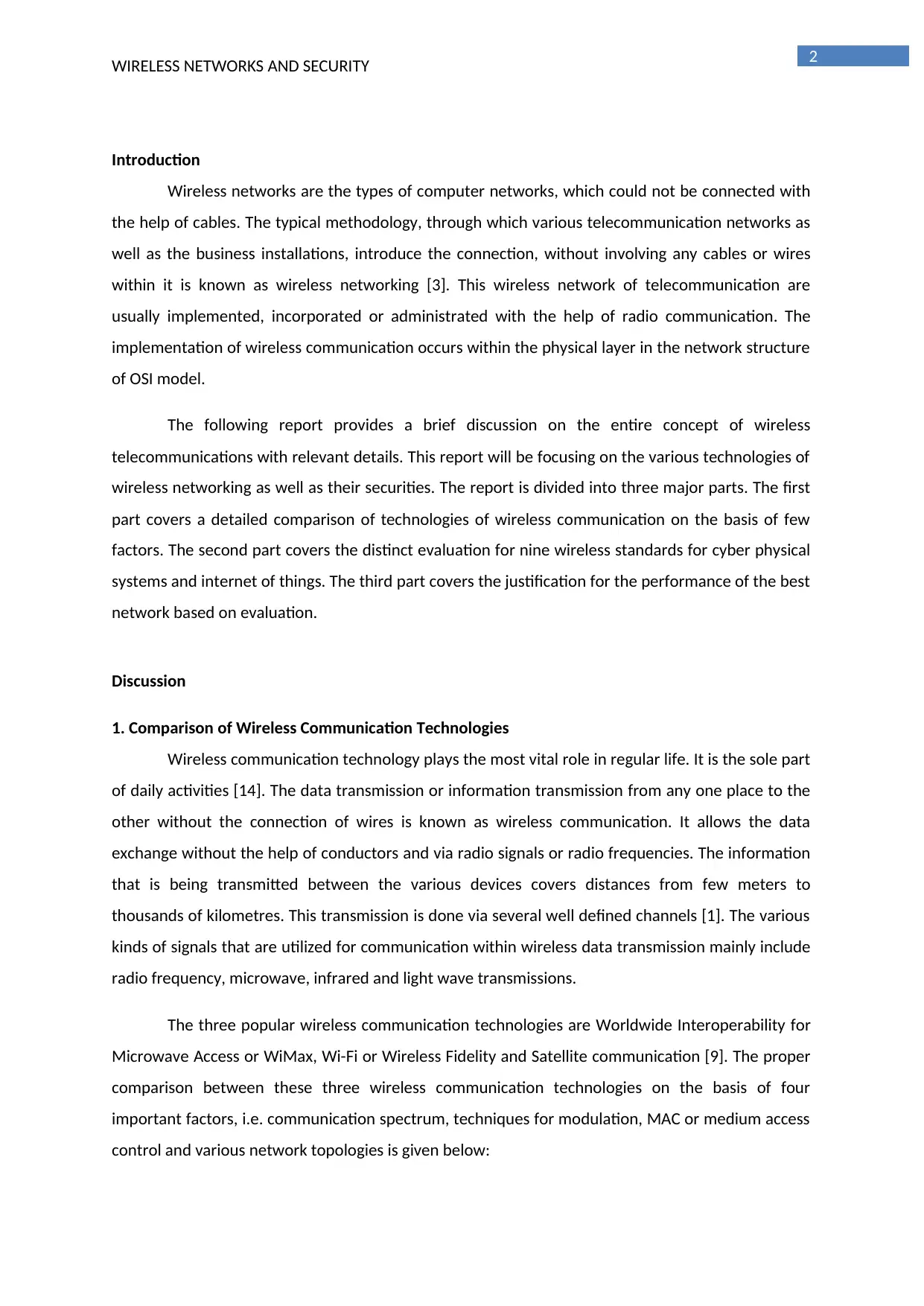
2
WIRELESS NETWORKS AND SECURITY
Introduction
Wireless networks are the types of computer networks, which could not be connected with
the help of cables. The typical methodology, through which various telecommunication networks as
well as the business installations, introduce the connection, without involving any cables or wires
within it is known as wireless networking [3]. This wireless network of telecommunication are
usually implemented, incorporated or administrated with the help of radio communication. The
implementation of wireless communication occurs within the physical layer in the network structure
of OSI model.
The following report provides a brief discussion on the entire concept of wireless
telecommunications with relevant details. This report will be focusing on the various technologies of
wireless networking as well as their securities. The report is divided into three major parts. The first
part covers a detailed comparison of technologies of wireless communication on the basis of few
factors. The second part covers the distinct evaluation for nine wireless standards for cyber physical
systems and internet of things. The third part covers the justification for the performance of the best
network based on evaluation.
Discussion
1. Comparison of Wireless Communication Technologies
Wireless communication technology plays the most vital role in regular life. It is the sole part
of daily activities [14]. The data transmission or information transmission from any one place to the
other without the connection of wires is known as wireless communication. It allows the data
exchange without the help of conductors and via radio signals or radio frequencies. The information
that is being transmitted between the various devices covers distances from few meters to
thousands of kilometres. This transmission is done via several well defined channels [1]. The various
kinds of signals that are utilized for communication within wireless data transmission mainly include
radio frequency, microwave, infrared and light wave transmissions.
The three popular wireless communication technologies are Worldwide Interoperability for
Microwave Access or WiMax, Wi-Fi or Wireless Fidelity and Satellite communication [9]. The proper
comparison between these three wireless communication technologies on the basis of four
important factors, i.e. communication spectrum, techniques for modulation, MAC or medium access
control and various network topologies is given below:
WIRELESS NETWORKS AND SECURITY
Introduction
Wireless networks are the types of computer networks, which could not be connected with
the help of cables. The typical methodology, through which various telecommunication networks as
well as the business installations, introduce the connection, without involving any cables or wires
within it is known as wireless networking [3]. This wireless network of telecommunication are
usually implemented, incorporated or administrated with the help of radio communication. The
implementation of wireless communication occurs within the physical layer in the network structure
of OSI model.
The following report provides a brief discussion on the entire concept of wireless
telecommunications with relevant details. This report will be focusing on the various technologies of
wireless networking as well as their securities. The report is divided into three major parts. The first
part covers a detailed comparison of technologies of wireless communication on the basis of few
factors. The second part covers the distinct evaluation for nine wireless standards for cyber physical
systems and internet of things. The third part covers the justification for the performance of the best
network based on evaluation.
Discussion
1. Comparison of Wireless Communication Technologies
Wireless communication technology plays the most vital role in regular life. It is the sole part
of daily activities [14]. The data transmission or information transmission from any one place to the
other without the connection of wires is known as wireless communication. It allows the data
exchange without the help of conductors and via radio signals or radio frequencies. The information
that is being transmitted between the various devices covers distances from few meters to
thousands of kilometres. This transmission is done via several well defined channels [1]. The various
kinds of signals that are utilized for communication within wireless data transmission mainly include
radio frequency, microwave, infrared and light wave transmissions.
The three popular wireless communication technologies are Worldwide Interoperability for
Microwave Access or WiMax, Wi-Fi or Wireless Fidelity and Satellite communication [9]. The proper
comparison between these three wireless communication technologies on the basis of four
important factors, i.e. communication spectrum, techniques for modulation, MAC or medium access
control and various network topologies is given below:
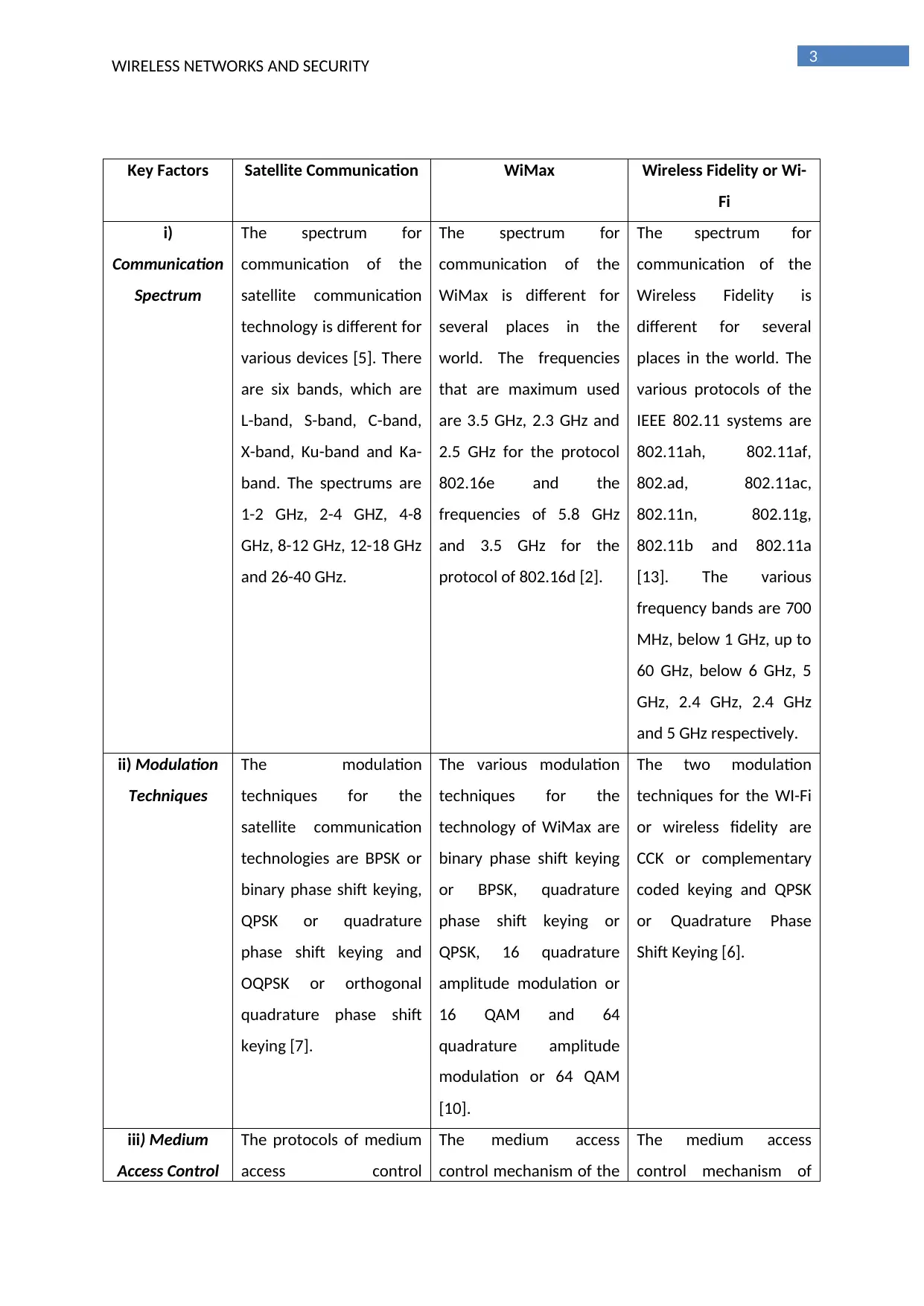
3
WIRELESS NETWORKS AND SECURITY
Key Factors Satellite Communication WiMax Wireless Fidelity or Wi-
Fi
i)
Communication
Spectrum
The spectrum for
communication of the
satellite communication
technology is different for
various devices [5]. There
are six bands, which are
L-band, S-band, C-band,
X-band, Ku-band and Ka-
band. The spectrums are
1-2 GHz, 2-4 GHZ, 4-8
GHz, 8-12 GHz, 12-18 GHz
and 26-40 GHz.
The spectrum for
communication of the
WiMax is different for
several places in the
world. The frequencies
that are maximum used
are 3.5 GHz, 2.3 GHz and
2.5 GHz for the protocol
802.16e and the
frequencies of 5.8 GHz
and 3.5 GHz for the
protocol of 802.16d [2].
The spectrum for
communication of the
Wireless Fidelity is
different for several
places in the world. The
various protocols of the
IEEE 802.11 systems are
802.11ah, 802.11af,
802.ad, 802.11ac,
802.11n, 802.11g,
802.11b and 802.11a
[13]. The various
frequency bands are 700
MHz, below 1 GHz, up to
60 GHz, below 6 GHz, 5
GHz, 2.4 GHz, 2.4 GHz
and 5 GHz respectively.
ii) Modulation
Techniques
The modulation
techniques for the
satellite communication
technologies are BPSK or
binary phase shift keying,
QPSK or quadrature
phase shift keying and
OQPSK or orthogonal
quadrature phase shift
keying [7].
The various modulation
techniques for the
technology of WiMax are
binary phase shift keying
or BPSK, quadrature
phase shift keying or
QPSK, 16 quadrature
amplitude modulation or
16 QAM and 64
quadrature amplitude
modulation or 64 QAM
[10].
The two modulation
techniques for the WI-Fi
or wireless fidelity are
CCK or complementary
coded keying and QPSK
or Quadrature Phase
Shift Keying [6].
iii) Medium
Access Control
The protocols of medium
access control
The medium access
control mechanism of the
The medium access
control mechanism of
WIRELESS NETWORKS AND SECURITY
Key Factors Satellite Communication WiMax Wireless Fidelity or Wi-
Fi
i)
Communication
Spectrum
The spectrum for
communication of the
satellite communication
technology is different for
various devices [5]. There
are six bands, which are
L-band, S-band, C-band,
X-band, Ku-band and Ka-
band. The spectrums are
1-2 GHz, 2-4 GHZ, 4-8
GHz, 8-12 GHz, 12-18 GHz
and 26-40 GHz.
The spectrum for
communication of the
WiMax is different for
several places in the
world. The frequencies
that are maximum used
are 3.5 GHz, 2.3 GHz and
2.5 GHz for the protocol
802.16e and the
frequencies of 5.8 GHz
and 3.5 GHz for the
protocol of 802.16d [2].
The spectrum for
communication of the
Wireless Fidelity is
different for several
places in the world. The
various protocols of the
IEEE 802.11 systems are
802.11ah, 802.11af,
802.ad, 802.11ac,
802.11n, 802.11g,
802.11b and 802.11a
[13]. The various
frequency bands are 700
MHz, below 1 GHz, up to
60 GHz, below 6 GHz, 5
GHz, 2.4 GHz, 2.4 GHz
and 5 GHz respectively.
ii) Modulation
Techniques
The modulation
techniques for the
satellite communication
technologies are BPSK or
binary phase shift keying,
QPSK or quadrature
phase shift keying and
OQPSK or orthogonal
quadrature phase shift
keying [7].
The various modulation
techniques for the
technology of WiMax are
binary phase shift keying
or BPSK, quadrature
phase shift keying or
QPSK, 16 quadrature
amplitude modulation or
16 QAM and 64
quadrature amplitude
modulation or 64 QAM
[10].
The two modulation
techniques for the WI-Fi
or wireless fidelity are
CCK or complementary
coded keying and QPSK
or Quadrature Phase
Shift Keying [6].
iii) Medium
Access Control
The protocols of medium
access control
The medium access
control mechanism of the
The medium access
control mechanism of
Paraphrase This Document
Need a fresh take? Get an instant paraphrase of this document with our AI Paraphraser
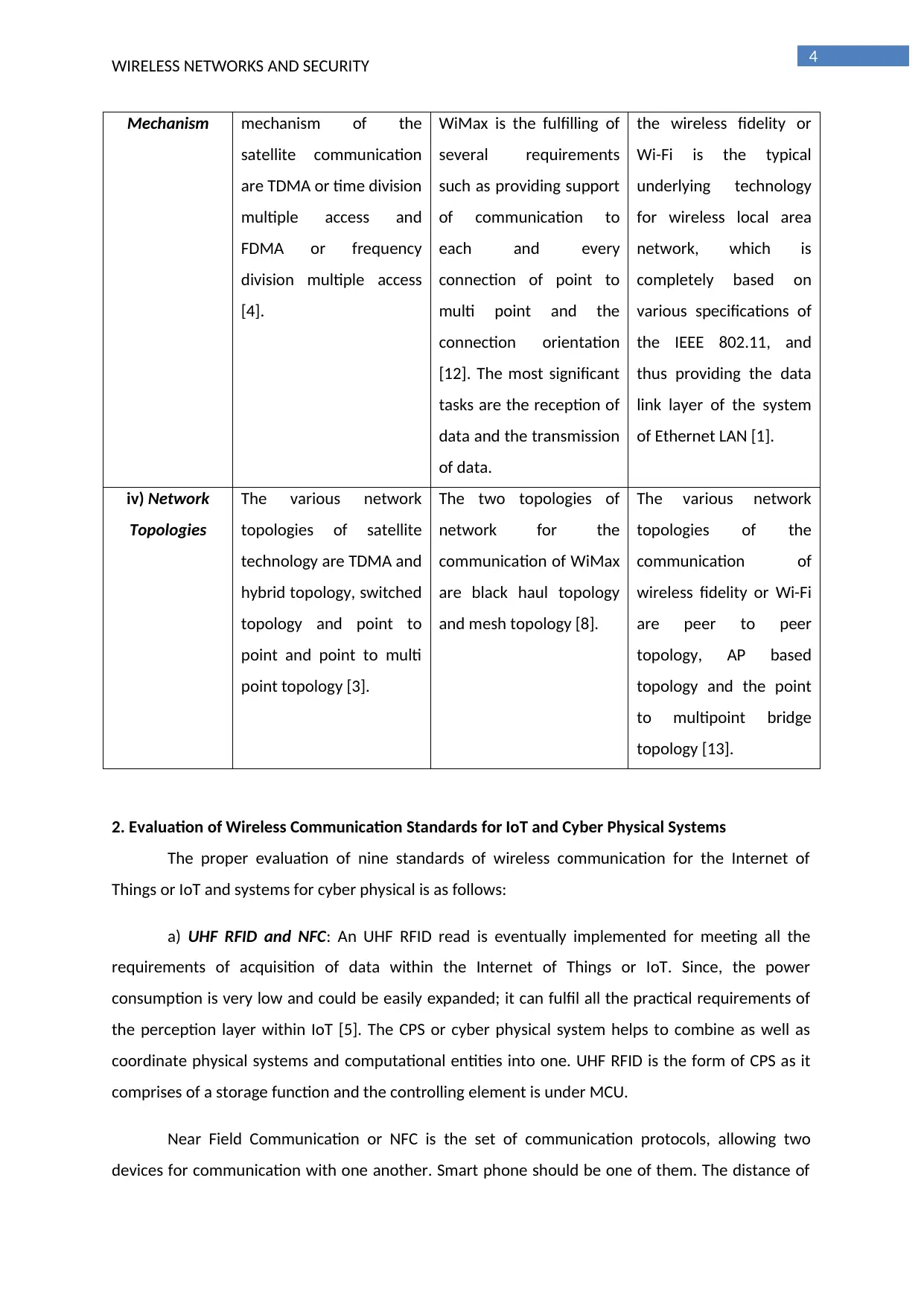
4
WIRELESS NETWORKS AND SECURITY
Mechanism mechanism of the
satellite communication
are TDMA or time division
multiple access and
FDMA or frequency
division multiple access
[4].
WiMax is the fulfilling of
several requirements
such as providing support
of communication to
each and every
connection of point to
multi point and the
connection orientation
[12]. The most significant
tasks are the reception of
data and the transmission
of data.
the wireless fidelity or
Wi-Fi is the typical
underlying technology
for wireless local area
network, which is
completely based on
various specifications of
the IEEE 802.11, and
thus providing the data
link layer of the system
of Ethernet LAN [1].
iv) Network
Topologies
The various network
topologies of satellite
technology are TDMA and
hybrid topology, switched
topology and point to
point and point to multi
point topology [3].
The two topologies of
network for the
communication of WiMax
are black haul topology
and mesh topology [8].
The various network
topologies of the
communication of
wireless fidelity or Wi-Fi
are peer to peer
topology, AP based
topology and the point
to multipoint bridge
topology [13].
2. Evaluation of Wireless Communication Standards for IoT and Cyber Physical Systems
The proper evaluation of nine standards of wireless communication for the Internet of
Things or IoT and systems for cyber physical is as follows:
a) UHF RFID and NFC: An UHF RFID read is eventually implemented for meeting all the
requirements of acquisition of data within the Internet of Things or IoT. Since, the power
consumption is very low and could be easily expanded; it can fulfil all the practical requirements of
the perception layer within IoT [5]. The CPS or cyber physical system helps to combine as well as
coordinate physical systems and computational entities into one. UHF RFID is the form of CPS as it
comprises of a storage function and the controlling element is under MCU.
Near Field Communication or NFC is the set of communication protocols, allowing two
devices for communication with one another. Smart phone should be one of them. The distance of
WIRELESS NETWORKS AND SECURITY
Mechanism mechanism of the
satellite communication
are TDMA or time division
multiple access and
FDMA or frequency
division multiple access
[4].
WiMax is the fulfilling of
several requirements
such as providing support
of communication to
each and every
connection of point to
multi point and the
connection orientation
[12]. The most significant
tasks are the reception of
data and the transmission
of data.
the wireless fidelity or
Wi-Fi is the typical
underlying technology
for wireless local area
network, which is
completely based on
various specifications of
the IEEE 802.11, and
thus providing the data
link layer of the system
of Ethernet LAN [1].
iv) Network
Topologies
The various network
topologies of satellite
technology are TDMA and
hybrid topology, switched
topology and point to
point and point to multi
point topology [3].
The two topologies of
network for the
communication of WiMax
are black haul topology
and mesh topology [8].
The various network
topologies of the
communication of
wireless fidelity or Wi-Fi
are peer to peer
topology, AP based
topology and the point
to multipoint bridge
topology [13].
2. Evaluation of Wireless Communication Standards for IoT and Cyber Physical Systems
The proper evaluation of nine standards of wireless communication for the Internet of
Things or IoT and systems for cyber physical is as follows:
a) UHF RFID and NFC: An UHF RFID read is eventually implemented for meeting all the
requirements of acquisition of data within the Internet of Things or IoT. Since, the power
consumption is very low and could be easily expanded; it can fulfil all the practical requirements of
the perception layer within IoT [5]. The CPS or cyber physical system helps to combine as well as
coordinate physical systems and computational entities into one. UHF RFID is the form of CPS as it
comprises of a storage function and the controlling element is under MCU.
Near Field Communication or NFC is the set of communication protocols, allowing two
devices for communication with one another. Smart phone should be one of them. The distance of
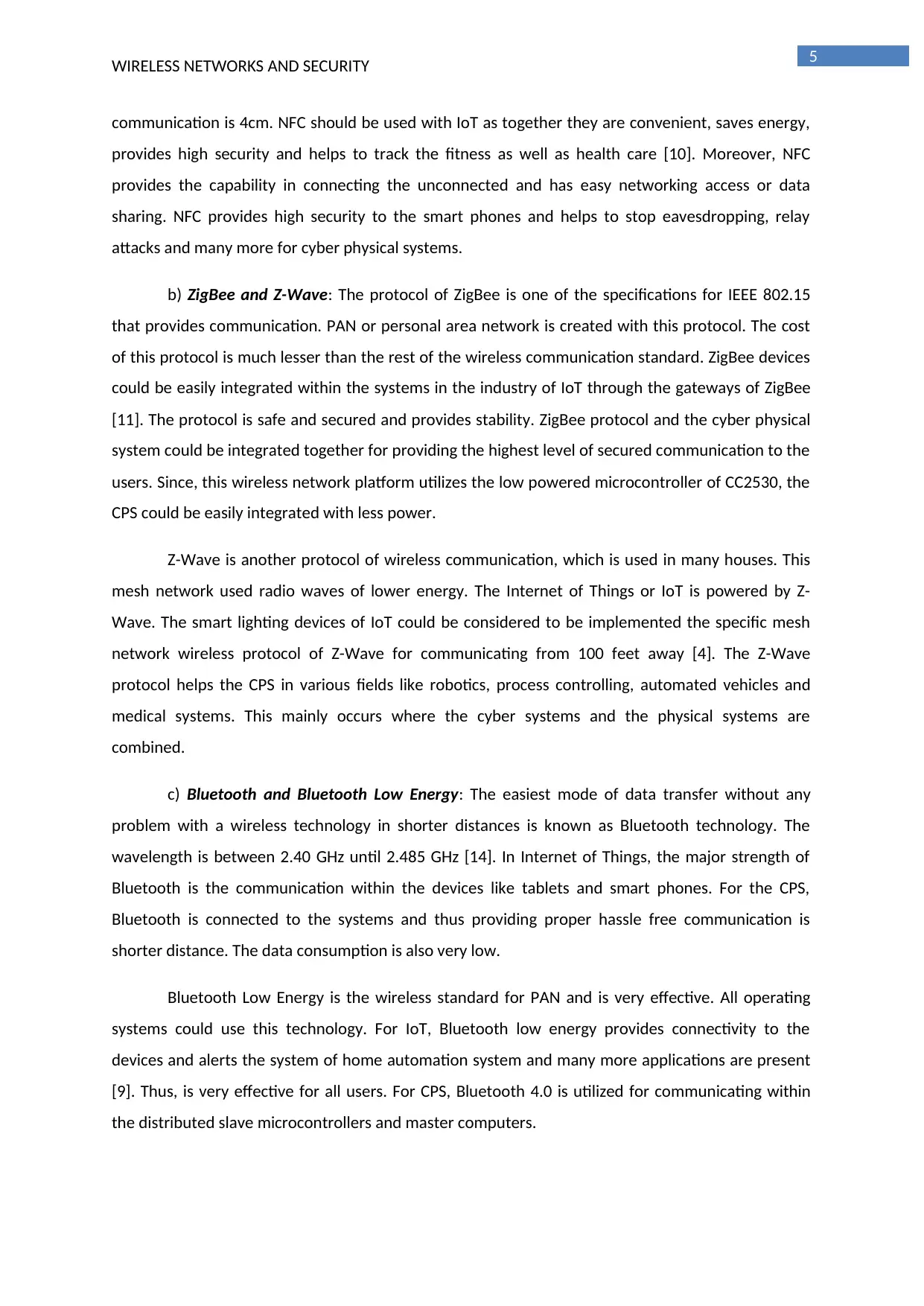
5
WIRELESS NETWORKS AND SECURITY
communication is 4cm. NFC should be used with IoT as together they are convenient, saves energy,
provides high security and helps to track the fitness as well as health care [10]. Moreover, NFC
provides the capability in connecting the unconnected and has easy networking access or data
sharing. NFC provides high security to the smart phones and helps to stop eavesdropping, relay
attacks and many more for cyber physical systems.
b) ZigBee and Z-Wave: The protocol of ZigBee is one of the specifications for IEEE 802.15
that provides communication. PAN or personal area network is created with this protocol. The cost
of this protocol is much lesser than the rest of the wireless communication standard. ZigBee devices
could be easily integrated within the systems in the industry of IoT through the gateways of ZigBee
[11]. The protocol is safe and secured and provides stability. ZigBee protocol and the cyber physical
system could be integrated together for providing the highest level of secured communication to the
users. Since, this wireless network platform utilizes the low powered microcontroller of CC2530, the
CPS could be easily integrated with less power.
Z-Wave is another protocol of wireless communication, which is used in many houses. This
mesh network used radio waves of lower energy. The Internet of Things or IoT is powered by Z-
Wave. The smart lighting devices of IoT could be considered to be implemented the specific mesh
network wireless protocol of Z-Wave for communicating from 100 feet away [4]. The Z-Wave
protocol helps the CPS in various fields like robotics, process controlling, automated vehicles and
medical systems. This mainly occurs where the cyber systems and the physical systems are
combined.
c) Bluetooth and Bluetooth Low Energy: The easiest mode of data transfer without any
problem with a wireless technology in shorter distances is known as Bluetooth technology. The
wavelength is between 2.40 GHz until 2.485 GHz [14]. In Internet of Things, the major strength of
Bluetooth is the communication within the devices like tablets and smart phones. For the CPS,
Bluetooth is connected to the systems and thus providing proper hassle free communication is
shorter distance. The data consumption is also very low.
Bluetooth Low Energy is the wireless standard for PAN and is very effective. All operating
systems could use this technology. For IoT, Bluetooth low energy provides connectivity to the
devices and alerts the system of home automation system and many more applications are present
[9]. Thus, is very effective for all users. For CPS, Bluetooth 4.0 is utilized for communicating within
the distributed slave microcontrollers and master computers.
WIRELESS NETWORKS AND SECURITY
communication is 4cm. NFC should be used with IoT as together they are convenient, saves energy,
provides high security and helps to track the fitness as well as health care [10]. Moreover, NFC
provides the capability in connecting the unconnected and has easy networking access or data
sharing. NFC provides high security to the smart phones and helps to stop eavesdropping, relay
attacks and many more for cyber physical systems.
b) ZigBee and Z-Wave: The protocol of ZigBee is one of the specifications for IEEE 802.15
that provides communication. PAN or personal area network is created with this protocol. The cost
of this protocol is much lesser than the rest of the wireless communication standard. ZigBee devices
could be easily integrated within the systems in the industry of IoT through the gateways of ZigBee
[11]. The protocol is safe and secured and provides stability. ZigBee protocol and the cyber physical
system could be integrated together for providing the highest level of secured communication to the
users. Since, this wireless network platform utilizes the low powered microcontroller of CC2530, the
CPS could be easily integrated with less power.
Z-Wave is another protocol of wireless communication, which is used in many houses. This
mesh network used radio waves of lower energy. The Internet of Things or IoT is powered by Z-
Wave. The smart lighting devices of IoT could be considered to be implemented the specific mesh
network wireless protocol of Z-Wave for communicating from 100 feet away [4]. The Z-Wave
protocol helps the CPS in various fields like robotics, process controlling, automated vehicles and
medical systems. This mainly occurs where the cyber systems and the physical systems are
combined.
c) Bluetooth and Bluetooth Low Energy: The easiest mode of data transfer without any
problem with a wireless technology in shorter distances is known as Bluetooth technology. The
wavelength is between 2.40 GHz until 2.485 GHz [14]. In Internet of Things, the major strength of
Bluetooth is the communication within the devices like tablets and smart phones. For the CPS,
Bluetooth is connected to the systems and thus providing proper hassle free communication is
shorter distance. The data consumption is also very low.
Bluetooth Low Energy is the wireless standard for PAN and is very effective. All operating
systems could use this technology. For IoT, Bluetooth low energy provides connectivity to the
devices and alerts the system of home automation system and many more applications are present
[9]. Thus, is very effective for all users. For CPS, Bluetooth 4.0 is utilized for communicating within
the distributed slave microcontrollers and master computers.

6
WIRELESS NETWORKS AND SECURITY
d) Cellular Systems: The cellular system in IoT is known as the Cellular Internet of Things or
CIoT and has three distinct technologies, which are NB IoT, EC GSM IoT and LTE M. All these
technologies are the most effective and efficient technologies in radio access [7]. The cellular
systems for the CPS are known as mobile cyber physical system and provide various communication
radios, intelligent applications, computational resources and many others.
e) IEEE 802.11p: The amendment of IEEE 802.11, this protocol is effective when enabled
with the IoT. It supports communications in vehicular speeds and thus the protocol is the most
utilized technology. For CPS, it provides smart transportations to the users.
f) LPWAN: The low power wide area network with IoT has various players like Weightless
SIG, Sigfox and Ingenu [5]. All of them are much effective. For CPS, this network provides connection
to huge distance with very less power consumption.
3. Wireless Network Performance
On the basis of evaluation for the Internet of Things or IoT and systems for cyber physical,
the best network performance is UHF RFID. One of the most effective as well as RFID provides
extremely higher frequency bandwidth. UHF RFID or ultra high frequency RFID device explicitly
covers the basic range of 300 MHz until 3 GHz. Thus, it is the best.
Conclusion
Therefore, from the above discussion, it can be concluded that, the basic utilization of this
wireless network helps the organizations in avoiding all the expensive processes for the introduction
of cables within houses or buildings. The connection between two or more different locations could
be easily done with the wireless network. The wireless connections of data have become extremely
popular within various network nodes. The above report has properly outlined the details of the
wireless telecommunications with the help of various examples. The most significant examples of
the wireless networks mainly include wireless sensor networks, WLAN or wireless local area
network, networks of cell phones, microwave networks, satellite telecommunication networks and
many more. Subdivision of the report is done on the basis of various factors. The first part is the
comparison of wireless communication technologies in terms of four factors. The second subdivision
is the evaluation of wireless communication standards for cyber physical systems and internet of
things and the third part is the identification of the wireless communication standard based on the
evaluation of wireless communication standards for cyber physical systems and internet of things.
WIRELESS NETWORKS AND SECURITY
d) Cellular Systems: The cellular system in IoT is known as the Cellular Internet of Things or
CIoT and has three distinct technologies, which are NB IoT, EC GSM IoT and LTE M. All these
technologies are the most effective and efficient technologies in radio access [7]. The cellular
systems for the CPS are known as mobile cyber physical system and provide various communication
radios, intelligent applications, computational resources and many others.
e) IEEE 802.11p: The amendment of IEEE 802.11, this protocol is effective when enabled
with the IoT. It supports communications in vehicular speeds and thus the protocol is the most
utilized technology. For CPS, it provides smart transportations to the users.
f) LPWAN: The low power wide area network with IoT has various players like Weightless
SIG, Sigfox and Ingenu [5]. All of them are much effective. For CPS, this network provides connection
to huge distance with very less power consumption.
3. Wireless Network Performance
On the basis of evaluation for the Internet of Things or IoT and systems for cyber physical,
the best network performance is UHF RFID. One of the most effective as well as RFID provides
extremely higher frequency bandwidth. UHF RFID or ultra high frequency RFID device explicitly
covers the basic range of 300 MHz until 3 GHz. Thus, it is the best.
Conclusion
Therefore, from the above discussion, it can be concluded that, the basic utilization of this
wireless network helps the organizations in avoiding all the expensive processes for the introduction
of cables within houses or buildings. The connection between two or more different locations could
be easily done with the wireless network. The wireless connections of data have become extremely
popular within various network nodes. The above report has properly outlined the details of the
wireless telecommunications with the help of various examples. The most significant examples of
the wireless networks mainly include wireless sensor networks, WLAN or wireless local area
network, networks of cell phones, microwave networks, satellite telecommunication networks and
many more. Subdivision of the report is done on the basis of various factors. The first part is the
comparison of wireless communication technologies in terms of four factors. The second subdivision
is the evaluation of wireless communication standards for cyber physical systems and internet of
things and the third part is the identification of the wireless communication standard based on the
evaluation of wireless communication standards for cyber physical systems and internet of things.
Secure Best Marks with AI Grader
Need help grading? Try our AI Grader for instant feedback on your assignments.
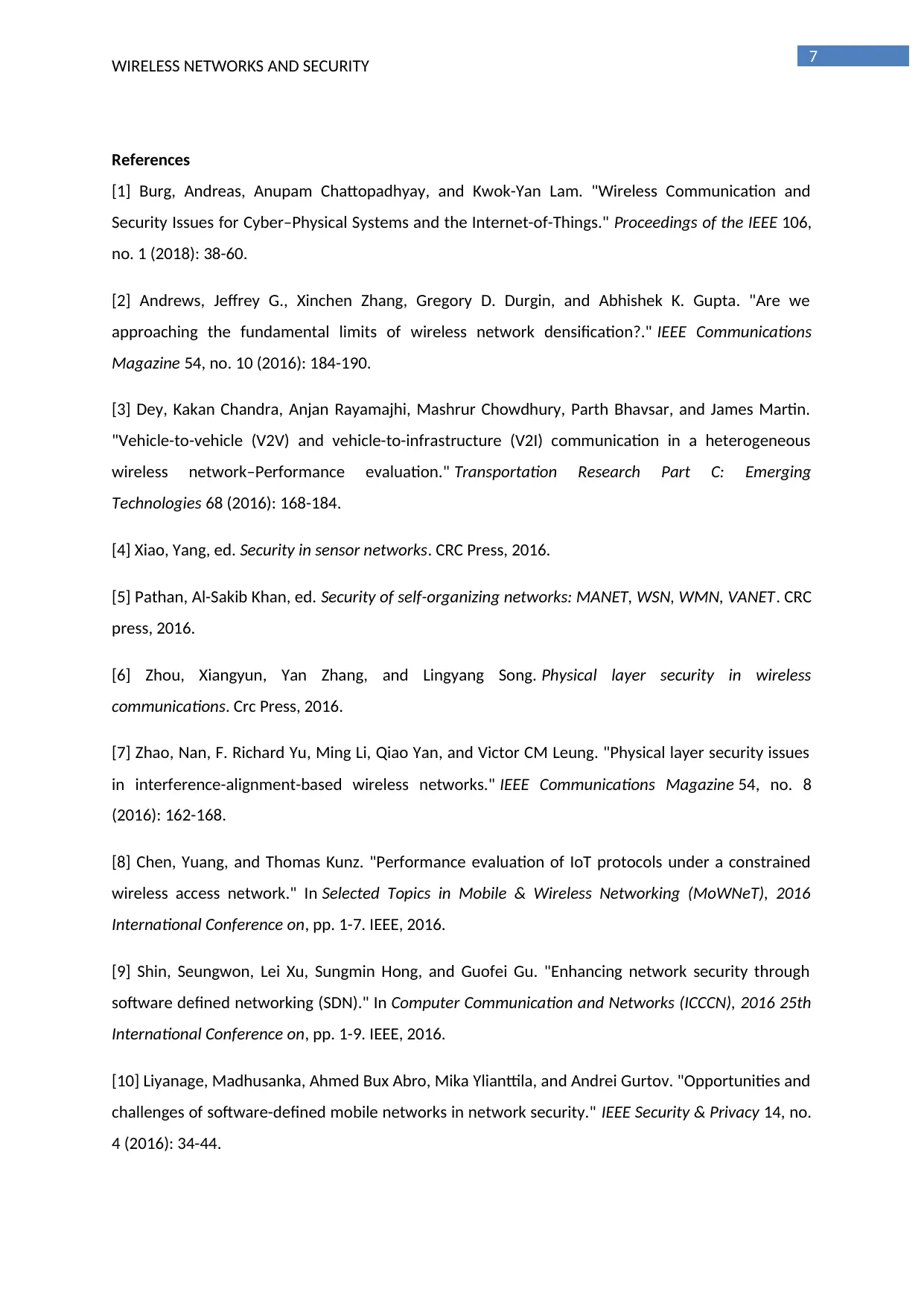
7
WIRELESS NETWORKS AND SECURITY
References
[1] Burg, Andreas, Anupam Chattopadhyay, and Kwok-Yan Lam. "Wireless Communication and
Security Issues for Cyber–Physical Systems and the Internet-of-Things." Proceedings of the IEEE 106,
no. 1 (2018): 38-60.
[2] Andrews, Jeffrey G., Xinchen Zhang, Gregory D. Durgin, and Abhishek K. Gupta. "Are we
approaching the fundamental limits of wireless network densification?." IEEE Communications
Magazine 54, no. 10 (2016): 184-190.
[3] Dey, Kakan Chandra, Anjan Rayamajhi, Mashrur Chowdhury, Parth Bhavsar, and James Martin.
"Vehicle-to-vehicle (V2V) and vehicle-to-infrastructure (V2I) communication in a heterogeneous
wireless network–Performance evaluation." Transportation Research Part C: Emerging
Technologies 68 (2016): 168-184.
[4] Xiao, Yang, ed. Security in sensor networks. CRC Press, 2016.
[5] Pathan, Al-Sakib Khan, ed. Security of self-organizing networks: MANET, WSN, WMN, VANET. CRC
press, 2016.
[6] Zhou, Xiangyun, Yan Zhang, and Lingyang Song. Physical layer security in wireless
communications. Crc Press, 2016.
[7] Zhao, Nan, F. Richard Yu, Ming Li, Qiao Yan, and Victor CM Leung. "Physical layer security issues
in interference-alignment-based wireless networks." IEEE Communications Magazine 54, no. 8
(2016): 162-168.
[8] Chen, Yuang, and Thomas Kunz. "Performance evaluation of IoT protocols under a constrained
wireless access network." In Selected Topics in Mobile & Wireless Networking (MoWNeT), 2016
International Conference on, pp. 1-7. IEEE, 2016.
[9] Shin, Seungwon, Lei Xu, Sungmin Hong, and Guofei Gu. "Enhancing network security through
software defined networking (SDN)." In Computer Communication and Networks (ICCCN), 2016 25th
International Conference on, pp. 1-9. IEEE, 2016.
[10] Liyanage, Madhusanka, Ahmed Bux Abro, Mika Ylianttila, and Andrei Gurtov. "Opportunities and
challenges of software-defined mobile networks in network security." IEEE Security & Privacy 14, no.
4 (2016): 34-44.
WIRELESS NETWORKS AND SECURITY
References
[1] Burg, Andreas, Anupam Chattopadhyay, and Kwok-Yan Lam. "Wireless Communication and
Security Issues for Cyber–Physical Systems and the Internet-of-Things." Proceedings of the IEEE 106,
no. 1 (2018): 38-60.
[2] Andrews, Jeffrey G., Xinchen Zhang, Gregory D. Durgin, and Abhishek K. Gupta. "Are we
approaching the fundamental limits of wireless network densification?." IEEE Communications
Magazine 54, no. 10 (2016): 184-190.
[3] Dey, Kakan Chandra, Anjan Rayamajhi, Mashrur Chowdhury, Parth Bhavsar, and James Martin.
"Vehicle-to-vehicle (V2V) and vehicle-to-infrastructure (V2I) communication in a heterogeneous
wireless network–Performance evaluation." Transportation Research Part C: Emerging
Technologies 68 (2016): 168-184.
[4] Xiao, Yang, ed. Security in sensor networks. CRC Press, 2016.
[5] Pathan, Al-Sakib Khan, ed. Security of self-organizing networks: MANET, WSN, WMN, VANET. CRC
press, 2016.
[6] Zhou, Xiangyun, Yan Zhang, and Lingyang Song. Physical layer security in wireless
communications. Crc Press, 2016.
[7] Zhao, Nan, F. Richard Yu, Ming Li, Qiao Yan, and Victor CM Leung. "Physical layer security issues
in interference-alignment-based wireless networks." IEEE Communications Magazine 54, no. 8
(2016): 162-168.
[8] Chen, Yuang, and Thomas Kunz. "Performance evaluation of IoT protocols under a constrained
wireless access network." In Selected Topics in Mobile & Wireless Networking (MoWNeT), 2016
International Conference on, pp. 1-7. IEEE, 2016.
[9] Shin, Seungwon, Lei Xu, Sungmin Hong, and Guofei Gu. "Enhancing network security through
software defined networking (SDN)." In Computer Communication and Networks (ICCCN), 2016 25th
International Conference on, pp. 1-9. IEEE, 2016.
[10] Liyanage, Madhusanka, Ahmed Bux Abro, Mika Ylianttila, and Andrei Gurtov. "Opportunities and
challenges of software-defined mobile networks in network security." IEEE Security & Privacy 14, no.
4 (2016): 34-44.
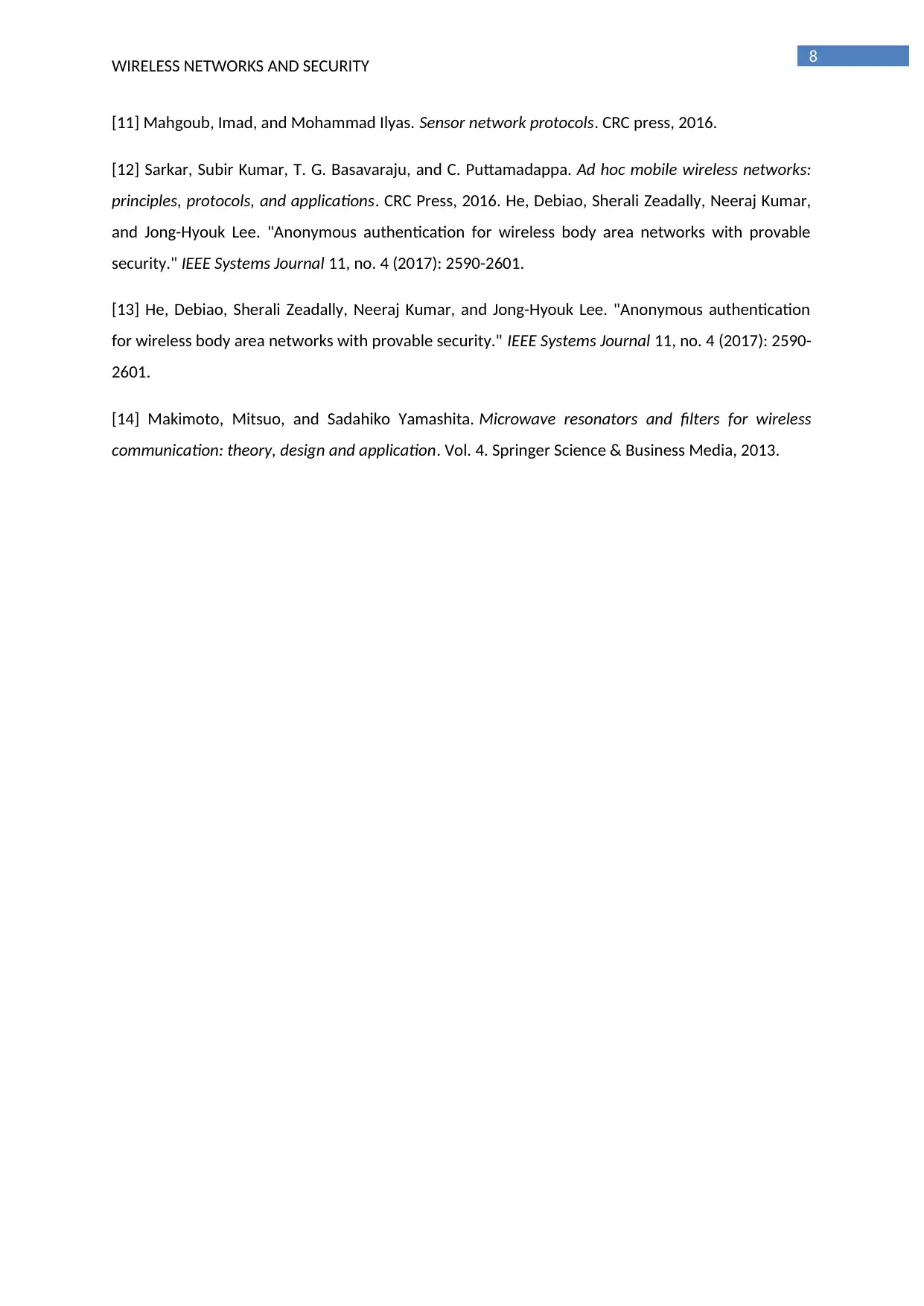
8
WIRELESS NETWORKS AND SECURITY
[11] Mahgoub, Imad, and Mohammad Ilyas. Sensor network protocols. CRC press, 2016.
[12] Sarkar, Subir Kumar, T. G. Basavaraju, and C. Puttamadappa. Ad hoc mobile wireless networks:
principles, protocols, and applications. CRC Press, 2016. He, Debiao, Sherali Zeadally, Neeraj Kumar,
and Jong-Hyouk Lee. "Anonymous authentication for wireless body area networks with provable
security." IEEE Systems Journal 11, no. 4 (2017): 2590-2601.
[13] He, Debiao, Sherali Zeadally, Neeraj Kumar, and Jong-Hyouk Lee. "Anonymous authentication
for wireless body area networks with provable security." IEEE Systems Journal 11, no. 4 (2017): 2590-
2601.
[14] Makimoto, Mitsuo, and Sadahiko Yamashita. Microwave resonators and filters for wireless
communication: theory, design and application. Vol. 4. Springer Science & Business Media, 2013.
WIRELESS NETWORKS AND SECURITY
[11] Mahgoub, Imad, and Mohammad Ilyas. Sensor network protocols. CRC press, 2016.
[12] Sarkar, Subir Kumar, T. G. Basavaraju, and C. Puttamadappa. Ad hoc mobile wireless networks:
principles, protocols, and applications. CRC Press, 2016. He, Debiao, Sherali Zeadally, Neeraj Kumar,
and Jong-Hyouk Lee. "Anonymous authentication for wireless body area networks with provable
security." IEEE Systems Journal 11, no. 4 (2017): 2590-2601.
[13] He, Debiao, Sherali Zeadally, Neeraj Kumar, and Jong-Hyouk Lee. "Anonymous authentication
for wireless body area networks with provable security." IEEE Systems Journal 11, no. 4 (2017): 2590-
2601.
[14] Makimoto, Mitsuo, and Sadahiko Yamashita. Microwave resonators and filters for wireless
communication: theory, design and application. Vol. 4. Springer Science & Business Media, 2013.
1 out of 9
![[object Object]](/_next/static/media/star-bottom.7253800d.svg)




